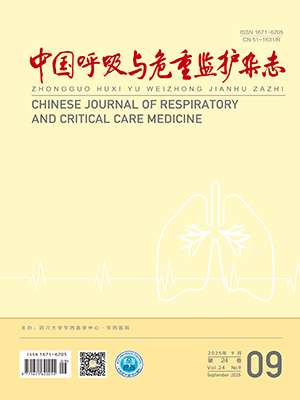| 1. |
Barker AF. Bronchiectasis. N Engl J Med, 2002, 346(18): 1383-1393.
|
| 2. |
Evans DJ, Greenstone M. Long-term antibiotics in the management of non-CF bronchiectasis--do they improve outcome?. Respir Med, 2003, 97(7): 851-858.
|
| 3. |
Martínez-García MA, Perpiñá-Tordera M, Román-Sánchez P, et al. Quality-of-life determinants in patients with clinically stable bronchiectasis. Chest, 2005, 128(2): 739-745.
|
| 4. |
Pasteur MC, Helliwell SM, Houghton SJ, et al. An investigation into causative factors in patients with bronchiectasis. Am J Respir Crit Care Med, 2000, 162(4 Pt 1): 1277-1284.
|
| 5. |
Tunney MM, Einarsson GG, Wei L, et al. Lung microbiota and bacterial abundance in patients with bronchiectasis when clinically stable and during exacerbation. Am J Respir Crit Care Med, 2013, 187(10): 1118-1126.
|
| 6. |
Byun MK, Chang J, Kim HJ, et al. Differences of lung microbiome in patients with clinically stable and exacerbated bronchiectasis. PLoS One, 2017, 12(8): e0183553.
|
| 7. |
Rogers GB, van der Gast CJ, Cuthbertson L, et al. Clinical measures of disease in adult non-CF bronchiectasis correlate with airway microbiota composition. Thorax, 2013, 68(8): 731-737.
|
| 8. |
McShane PJ, Naureckas ET, Tino G, et al. Non-cystic fibrosis bronchiectasis. Am J Respir Crit Care Med, 2013, 188(6): 647-656.
|
| 9. |
Fuchs HJ, Borowitz DS, Christiansen DH, et al. Effect of aerosolized recombinant human DNase on exacerbations of respiratory symptoms and on pulmonary function in patients with cystic fibrosis. The Pulmozyme Study Group. N Engl J Med, 1994, 331(10): 637-642.
|
| 10. |
Esty WW. The efficiency of Good's nonparametric coverage estimator. Ann Statist, 1986, 14(3): 1257-1260.
|
| 11. |
Rognes T, Flouri T, Nichols B, et al. VSEARCH: a versatile open source tool for metagenomics. PeerJ, 2016, 4: e2584.
|
| 12. |
Charlson ES, Bittinger K, Haas AR, et al. Topographical continuity of bacterial populations in the healthy human respiratory tract. Am J Respir Crit Care Med, 2011, 184(8): 957-963.
|
| 13. |
Dickson RP, Erb-Downward JR, Freeman CM, et al. Bacterial topography of the healthy human lower respiratory tract. mBio, 2017, 8(1): e02287-16.
|
| 14. |
Wang Z, Bafadhel M, Haldar K, et al. Lung microbiome dynamics in COPD exacerbations. Eur Respir J, 2016, 47(4): 1082-1092.
|
| 15. |
Polverino E, Goeminne PC, McDonnell MJ, et al. European Respiratory Society Guidelines for the management of adult bronchiectasis. Eur Respir J, 2017, 50(3): 1700629.
|
| 16. |
Tunney MM, Klem ER, Fodor AA, et al. Use of culture and molecular analysis to determine the effect of antibiotic treatment on microbial community diversity and abundance during exacerbation in patients with cystic fibrosis. Thorax, 2011, 66(7): 579-584.
|
| 17. |
Whelan FJ, Heirali AA, Rossi L, et al. Longitudinal sampling of the lung microbiota in individuals with cystic fibrosis. PLoS One, 2017, 12(3): e0172811.
|
| 18. |
Cox MJ, Turek EM, Hennessy C, et al. Longitudinal assessment of sputum microbiome by sequencing of the 16S rRNA gene in non-cystic fibrosis bronchiectasis patients. PLoS One, 2017, 12(2): e0170622.
|




